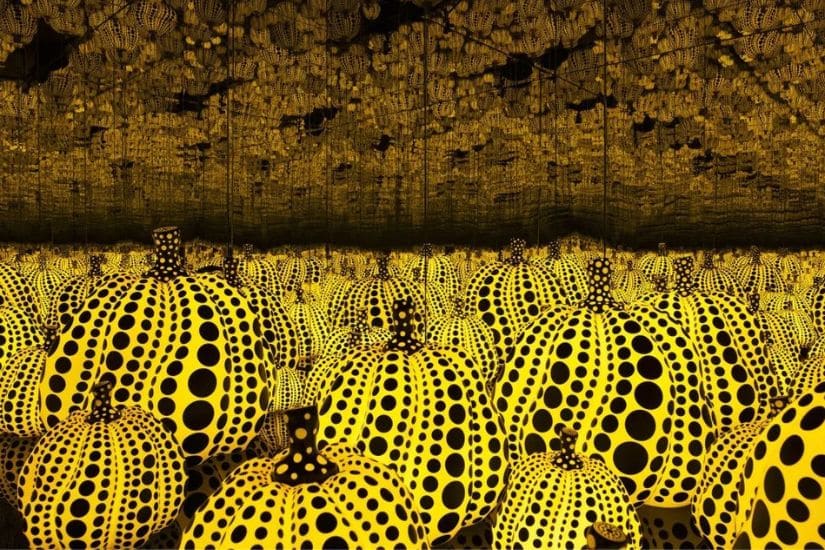The world-renowned contemporary Japanese artist Yayoi Kusama was born in 1929 in Matsumoto, Japan. She is known for her extensive use of polka dot patterns and infinity installations. The polka dot theme originated from Kusama’s childhood struggles with mental illness, where her world was surrounded by various intricate patterns, describing the feeling as if she was endlessly spinning in an infinite space. Later, she turned the struggles that had plagued her for years into creative elements, using art to soothe symptoms and confront the pain brought on by hallucinations.
Family conflicts and the desire to become an artist prompted her to move to the United States in 1957 and settle in New York City. Before leaving Japan, she destroyed many of her early paintings, demonstrating a determination to start anew. Her early works in New York City included her “Infinity Nets” paintings. These patterns, made up of thousands of tiny dots repeated endlessly on large canvases, seemed to extend infinitely. These works transcended the physical and psychological boundaries of traditional Japanese painting, creating an almost hypnotic feeling of endless repetition for both the viewer and the artist. Although her reputation in the New York art scene was not yet established, she told herself, “One day I will conquer New York and get everything I want.”



At that time, Kusama Yayoi persisted in creating day and night, developing a unique artistic path. In 1965, Yayoi Kusama created the world’s first mirror room installation at a New York gallery, which was the precursor to the Infinity Mirror Rooms. Her avant-garde creative ideas were even imitated by some more famous artists at the time, but those who stole her ideas received more attention than she did, leaving her feeling disheartened and even contemplating suicide.

In 1966, Yayoi Kusama arrived at the Venice Art Biennale exhibition hall with her 1500 mirrored balls without any invitation, and exhibited her “Narcissus Garden”. She sold her works outside the venue for a few dollars, only to be stopped by the organizers. This event brought Kusama great fame, and art galleries like MoMa in New York invited her to showcase avant-garde performance art. Gradually, her name began to be respected in the art world.

Until 1973, Kusama decided to return to her home country to receive treatment for mental illness. She moved into a sanatorium, where she continued to create art without stopping, even more crazily than before. The creative pain often accompanies suffering, and during this time, Kusama also established themes of infinity, accumulation, comprehensive connection, the biological universe, death, and the power of life.
After a period of isolation, Yayoi Kusama returned to the canvas, blurring the existence of real space with pumpkins covered in polka dots, endless lines, and overlapping vibrant flowers. In 1993, the Venice Biennale, which had once rejected her, invited Kusama to hold an exhibition. This time, she finally shocked the Western-dominated art world with her work, becoming a leading figure in contemporary avant-garde art.

Until now, Yayoi Kusama still lives in a mental institution, her daily creations make painting the best medicine for healing the soul. Yayoi Kusama describes herself as entering a state of “self-obliteration” through art, saying, “Turning myself into dust, floating in the endless universe with infinite time, reaching a state of selflessness.”
Since the beginning of her creative journey, she has chosen not to suppress the crazy fantasies in her mind, but instead freely paints her imagination on the canvas. She is obsessed with circles, as she believes that circles represent the universe and the path to self-disintegration. She shares, “Earth, moon, sun, stars, and even humans are all made up of circles. Earth is just a small circle in the vast universe… When people turn themselves and nature into circles, they can become one with the world.”

Until now, her iconic creations have become an important chapter in contemporary art history, with influence spreading across art, fashion, and trends, becoming a cultural symbol that everyone is eager to follow. Some say she is a genius, some say she is crazy, but in any successful artist, who isn’t driven by a kind of almost crazy obsession to create?
